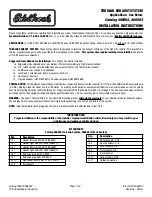
Temperature – A, B, C
The temperature grades are A (the highest), B, and C,
representing the tire’s resistance to the generation
of heat and its ability to dissipate heat when tested
under controlled conditions on a specified indoor
laboratory test wheel. Sustained high temperature
can cause the material of the tire to degenerate and
reduce tire life, and excessive temperature can lead to
sudden tire failure. The grade C corresponds to a
level of performance which all passenger car tires must
meet under the Federal Motor Vehicle Safety Standard
No. 109. Grades B and A represent higher levels of
performance on the laboratory test wheel than the
minimum required by law.
Warning: The temperature grade for this tire is
established for a tire that is properly inflated and not
overloaded. Excessive speed, underinflation, or
excessive loading, either separately or in combination,
can cause heat buildup and possible tire failure.
Wheel Alignment and Tire Balance
The wheels on your vehicle were aligned and balanced
carefully at the factory to give you the longest tire life
and best overall performance.
If you notice unusual tire wear or your vehicle pulling
one way or the other, the alignment may need to
be reset. If you notice your vehicle vibrating when
driving on a smooth road, your wheels may need to
be rebalanced.
5-61
Summary of Contents for Chevrolet SSR 2003
Page 5: ...These are some examples of symbols that may be found on the vehicle v...
Page 6: ...NOTES vi...
Page 60: ...NOTES 1 54...
Page 106: ...Instrument Panel Overview 3 2...
Page 186: ...NOTES 3 82...
Page 236: ...NOTES 4 50...
Page 248: ...Engine Compartment Overview When you open the hood on the engine you ll see 5 12...
Page 328: ...NOTES 5 92...
Page 346: ...Maintenance Record cont d Date Odometer Reading Serviced By Maintenance Record 6 18...
Page 347: ...Maintenance Record cont d Date Odometer Reading Serviced By Maintenance Record 6 19...
Page 348: ...Maintenance Record cont d Date Odometer Reading Serviced By Maintenance Record 6 20...
















































